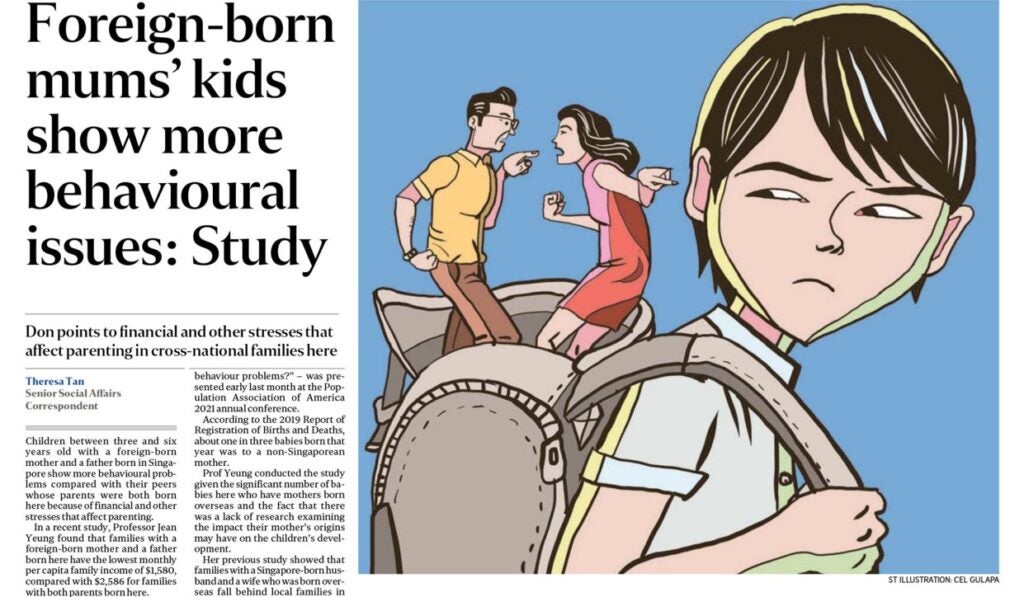Integration and Resilience of Cross-national Families in Singapore
In Asia, migration has been on the rise. However, unlike countries in the West or in Europe where migration is fairly well-distributed from within and between regions, the bulk of migration in Asia is intraregional. Due to large differences in levels of development and growth in the more developed economies, countries like Singapore, Taiwan, Japan and South Korea have become new destinations for migrant labour. Accordingly, intra-regional marriage migration parallels the increase in cross-border mobility. Migration movements across Asia also create increased opportunities for new relationships and marital unions.
A prominent form of gender-differentiated migration, marriage migration in Asia usually entails foreign brides crossing borders to join their husbands in more affluent Asian countries. Since the 1990s, the phenomenon of local men in developed Asian economies seeking to marry women from less developed Asian countries has been well documented. Singapore men, for instance, are known to marry women from developing countries around the region, such as Thailand, Vietnam, Philippines, Indonesia and China. Such marriages, initially facilitated by commercial matchmaking agencies, have been framed as a social issue, with migrant wives’ inability to integrate also viewed as a problem. In many of these countries, the influx of foreign brides has created tension and increased challenges to integration, especially in culturally- and linguistically-homogenous societies such as South Korea, Japan and Taiwan. Many of these women, who are routinely characterised as having low education and poor language skills, are less likely to be integrated due to the diminished chances of work and fewer opportunities to develop social networks and cultural familiarity outside of the family.
Cross-national marriages in Singapore
Similar to the trends seen in other developed countries in Asia, cross-national marriages in Singapore now account for almost a third of all marriages registered in the country, with the majority between a Singaporean groom (of various ethnicities) and a foreign bride. In a recent statement, Minister Heng Swee Keat announced that one in three citizen marriages involves a spouse from another country while one in five marriages were inter-ethnic. Similar to many developed Asian countries, marriages with non-citizen brides significantly outnumber those with non-citizen grooms.
Lower-income cross-national families consisting of a Singaporean husband and foreign wife have received the most attention in the public sphere. Such Singaporean husbands have been described as older, less educated and often encumbered by considerable economic challenges. For some men struggling to obtain gainful employment, marrying a foreign wife allows them to fulfil the desire for a family, although this may increase their burdens, given uncertainties about the immigration and residency status of their wives. These “multi-stressed”, lower-income cross-national families may experience unmet needs for secure housing and lack of stable visa for the foreign spouse or a reliable income (for some, all at once), making them more likely to repeatedly seek and rely on social welfare. A 2021 study by Yeung and Lu found that cross-national families with a foreign-born mother not only experience the highest levels of conflict within the family, but also have the lowest monthly per capita income.
 Source: The Straits Times.
Source: The Straits Times.
While it is often taken for granted that Singapore’s multi-cultural make-up provides a favourable background for diversity and integration, this may not always be the experience for migrant spouses. This is especially since the lower-income migrant bride’s journey for a more stable visa is known to be fraught with difficulties, with the approval process for visas also described as opaque.
With no permanent visa, many migrant wives lack equal access to employment and relatedly, other forms of social and cultural integration. According to research done by Amanda Chong, “[t]his results in a glaring incongruity: Migrant brides are perpetually transient outsiders, even though they have acquired permanent links to Singapore as wives and mothers of citizens.”
What is ‘integration’?
‘Integration’ is an often ill-defined yet widely-used term, used to signal ideas and values of acculturation, assimilation and social cohesion, while also overlapping at times with the ideals of multiculturalism. However, none of these definitions sui generis accurately encapsulates how migrant spouses and their family members experience integration or whether they may feel like ‘outsiders’. Assimilation or acculturation, for example, often reflects normative end goals, in which the migrant spouse has to transform or give up one’s own cultural values or practices to be recognised as part of the host society. This conflicts with many migrant spouses who may want to continually participate in transnational social and cultural fields post-migration and maintain ties to their homeland.
While it was relatively straightforward in the past for many foreign wives to attain citizenship, hence achieving some form of legal integration, ethnic and cultural diversity as a result of cross-national marriages have been presented as threats to national identity and social cohesion in recent years. Homeland marriages—the preference to marry partners from one’s ethnic homeland rather than natives or co-ethnics—for example, have produced concerns over integration, such as the “arrival of a first generation in every generation” in the UK. Nonetheless, the emergence of new formations of family through cross-national marriages means that understanding integration in the above outlined ways can be limiting, rather than serve as a springboard for deeper discussions about the integration and identities of migrant spouses and children from these families. Rather than unidirectional, integration is more likely to be an ever-evolving process, whereby outcomes measured at any point of time are a snapshot and not a permanent feature.
Integration as ways of being and belonging
An important aspect of our current research examines the everyday practices and social relations (that constitute more practical ‘ways of being’) and the ways in which they shape identity and the ‘ways of belonging’ for members of cross-national families. In approaching integration as a portmanteau of ‘ways of being’ and ‘belonging’, we investigate how the tangible aspects of everyday life are inseparable from the way that migrant spouses and children from cross-national families are able to feel like they belong. While migrant integration has often been framed as an individual issue, a more nuanced understanding acknowledges that integration is a complicated and contested set of quotidian processes occurring unevenly across structural social, cultural and civic/political domains.
In understanding integration, its everyday interactions and the more practical ways of being through these domains, the research also illuminates how integration is more likely to be relational, or dependent on the exchanges between the different domains and also the institutions and people amongst whom migrant spouses live. Although cross-national family members and children may already have achieved formal integration through permanent rights to stay in the country, they may not feel like they belong, nor feel accepted or able to exercise substantive citizenship. Constituting the more ‘tangible’, quotidian aspects of everyday life, the interrelated structural, social and cultural and civic/political domains have implications for cross-national family members to feel part of the host nation.
While there is an established body of literature in the west (and an emerging literature in Asia) that focuses on the challenges of cross-border families and marriages through the lens of social integration, much of the work on integration in Singapore has been more broadly focused on the immigrant population. This includes international students, skilled workers and new immigrants who move to the country (as families or individuals) for various reasons. This research on migrant spouses’ experiences of integration and their sense of belonging thus seeks to fill this gap in scholarship, as well as extend the work done on cross-national families across different socio-economic classes in Singapore.
Additionally, by incorporating the voices of children from cross-national families, the research will reveal (if any) the intergenerational differences of the experiences of integration and identity between parent and child, especially since relatively little research has focused on the views of children who grow up in cross-national households. Much of the literature on cross-national families and young family members remains adult-centric where an understanding of children’s lives are almost exclusively drawn from the perspectives of the parents or adults in the household.
Cross-national families can face a range of difficulties in their integration process that can trickle down to the shaping of the youth’s identities. Children from these households may encounter poverty, discrimination and prejudice as a result of their or their parents’ immigrant status whilst growing up. Studies in the west have found that immigrant youths, or youths with at least one immigrant parent, are more likely to experience mental and physical stress and isolation, resulting in poorer grades and school outcomes compared to local children.

Immigrant youths are more likely to experience mental and physical stress and isolation. Source: The Straits Times.
There is, however, a heterogeneity of cross-national families that cuts across a spectrum of socio-economic classes in Singapore, resulting in uneven experiences of integration for different groups of migrant spouses. A focus on the problems and disadvantages as a result of (poor) integration is one-sided, given that many cross-national families, migrant spouses and youths are also able to do well and thrive.
Integration can help us understand family resilience
Broadly speaking, family resilience is perceived as how impermeable the family is in times of crisis and/or how well family members are able to bounce back after encountering adversity. Family resilience is usually characterised as “the path a family follows as it adapts and prospers in the face of stress, both in the present and over time” and also takes into account “the capacity [of the family] to rebound from adversity strengthened and more resourceful.” Resilient families respond to difficulties in various ways which depend largely on context, a combination of risks and protective factors, and the family’s shared outlook, which certain cross-national families may lack access to or support from due to a lack of integration in the various domains.
For example, resilience in a migration context illuminates how some parents in cross-national families are able to develop capacities to respond to and cope with challenges with the help of their children raised in the host country. As marriage migrants who are poorly integrated do not gain sufficient social and cultural capital over the years, children of cross-national families are often expected to become ‘cultural brokers’ who mediate and provide support in a range of matters for their parents. For a number of children in cross-national families, this is often a role that other children with local parents do not have to assume.
Understanding the experiences of integration in cross-national families thus not only shows how resilience can be developed differently in different cross-national families, but also shows how forms of resilience in cross-national families may take place in other ways that are not present in local families. Understanding integration and the ways of being and belonging of cross-national family members across generations can be useful in developing a more interactive and systemic view of resilience that goes beyond seeing resilience as an individual trait inherent in certain families or family members. Integration and identity through the ways of being and belonging reveal how resilience is also a result of interactions with the broader social ecology and community, which can affect access to useful resources in times of need.
The views expressed in this forum are those of the individual authors and do not represent the views of the Asia Research Institute, National University of Singapore, or the institutions to which the authors are attached.
Bernice is a Research Fellow at ARI, working on an interdisciplinary project on the integration, identities and resilience of cross-national families and their youths in Singapore. She was previously a Postdoctoral and Research Fellow at the Centre for Family and Population Research (CFPR) at the National University of Singapore and a Research Officer at Monash University, Australia. Her research interests include youth and youth identities, gender, transnational families, mixed marriages and social inequalities. Her most recent monograph is based on her PhD and is entitled Tween Girls' Dressing and Young Femininity in Singapore.










